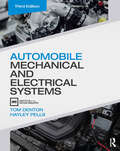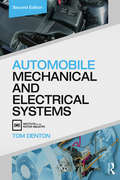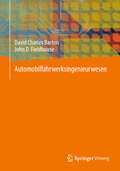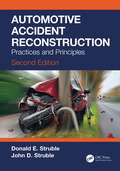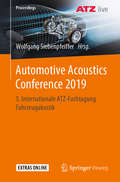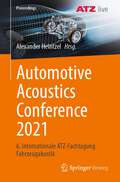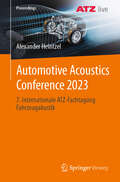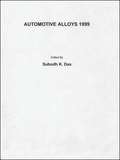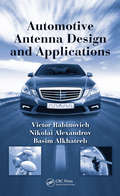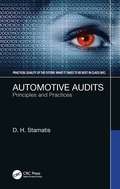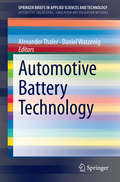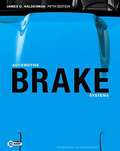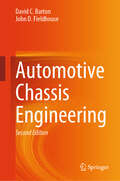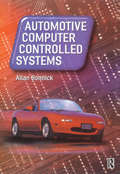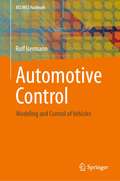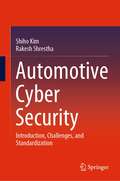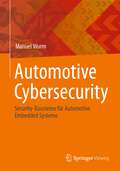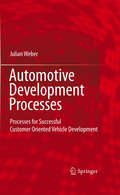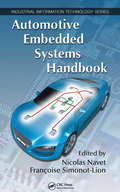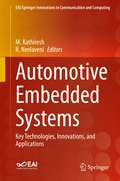- Table View
- List View
Automobile Mechanical and Electrical Systems
by Tom Denton Hayley PellsThe third edition of Automobile Mechanical and Electrical Systems concentrates on core technologies to provide the essential information required to understand how different vehicle systems work. It gives a complete overview of the components and workings of a vehicle from the engine through to the chassis and electronics. It also explains the necessary tools and equipment needed in effective car maintenance and repair, and relevant safety procedures are included throughout. Designed to make learning easier, this book contains: Photographs, flow charts and quick reference tables Detailed diagrams and clear descriptions that simplify the more complicated topics and aid revision Useful features throughout, including definitions, key facts and ‘safety first’ considerations. In full colour and with support materials from the author’s website (www.automotive-technology.org), this is the guide no student enrolled on an automotive maintenance and repair course should be without.
Automobile Mechanical and Electrical Systems: Automotive Technology - Vehicle Maintenance And Repair
by Tom DentonThe second edition of Automobile Mechanical and Electrical Systems concentrates on core technologies to provide the essential information required to understand how different vehicle systems work. It gives a complete overview of the components and workings of a vehicle from the engine through to the chassis and electronics. It also explains the necessary tools and equipment needed in effective car maintenance and repair, and relevant safety procedures are included throughout. Designed to make learning easier, this book contains: Photographs, flow charts and quick reference tables Detailed diagrams and clear descriptions that simplify the more complicated topics and aid revision Useful features throughout, including definitions, key facts and ‘safety first’ considerations. In full colour and with support materials from the author’s website (www.automotive-technology.org), this is the guide no student enrolled on an automotive maintenance and repair course should be without.
Automobilergonomie (ATZ/MTZ-Fachbuch)
by Heiner Bubb Klaus Bengler Rainer E. Grünen Mark VollrathErgonomie lehrt, wie Technik so zu gestalten ist, dass sie optimal an die Bed#65533;rfnisse, W#65533;nsche und Eigenschaften des Nutzers angepasst ist. Es hat sich in diesem Zusammenhang der Begriff vom Mensch-Maschine-System etabliert. Sachsystematisch und mit detailliertem Blick auf die komplizierten technischen und wahrnehmungspsychologischen und methodischen Zusammenh#65533;nge werden in diesem Buch die Grundlagen mit zahlreichen Beispielen erkl#65533;rt. Dabei zeigt sich die Anwendung der Fahrzeugergonomie in den Beispielen wie Package, Gestaltung von Anzeigen und Bedienelementen, von Umweltergonomie wie Beleuchtung, Schall, Schwingungen, Klima und Geruch. Auch die Gestaltung von Fahrerassistenzsystemen aus ergonomischer Sicht ist ein zentrales Thema. Abgerundet wird das Buch durch Methoden der ergonomischen Fahrzeugentwicklung, die Nutzung von Mock-Ups, Fahrsimulatoren und von Versuchen in Realfahrzeugen und Prototypen. Erstmals wird den Verantwortlichen in der Automobilindustrie und im Bereich der einschl#65533;gigen Forschung ein fachsystematisches Werk an die Hand gegeben, das die ergonomischen Erkenntnisse bei der Gestaltung heutiger Automobile bereitstellt. Damit erhalten Planer und Konstrukteur heutiger Automobile konkrete Angaben f#65533;r die ergonomische Produktentwicklung und k#65533;nnen so entscheidende Anforderungen und die sp#65533;tere Kundenakzeptanz im Blick behalten.
Automobilfahrwerksingenieurwesen
by John D. Fieldhouse David Charles BartonFür Studierende und Praktiker im Bereich Fahrzeugtechnik geschrieben, bietet dieses Buch ein grundlegendes, aber umfassendes Verständnis der Fahrwerksysteme und erfordert nur geringe Vorkenntnisse seitens der Leser. Es präsentiert das Material auf praktische und realistische Weise und verwendet Reverse Engineering als Grundlage für Beispiele, um das Verständnis der Themen zu verstärken. Die Spezifikationen und Merkmale von Fahrzeugen, die derzeit auf dem Markt sind, werden genutzt, um die Anwendung der Theorie zu veranschaulichen, und es wird darauf geachtet, die verschiedenen behandelten Themen zu verbinden, um ihre Zusammenhänge klar darzustellen. Diese zweite Auflage ist vollständig aktualisiert und überarbeitet und umfasst ein neues Kapitel zum Verzögerungsverhalten von Fahrzeugen. Das Buch beginnt mit einem Kapitel über grundlegende Fahrzeugmechanik, das die auf ein sich bewegendes Fahrzeug wirkenden Kräfte unter der Annahme eines starren Körpers behandelt. Das neue Kapitel über das Verzögerungsverhalten von Fahrzeugen führt die grundlegenden Konzepte eines herkömmlichen Bremsystems ein, bevor es Möglichkeiten zur Optimierung der Verzögerungsleistung eines jeden radgebremsten Fahrzeugs basierend auf den Haftungsverhältnissen von Reifen und Straße betrachtet. Das nächste Kapitel konzentriert sich auf die Fahrzeugdynamik, indem es die Federungssysteme und die Interaktion der wichtigen Komponenten des Systems, wie Reifen, Verbindungen, Federn, Stoßdämpfer usw., zur Erzielung der erforderlichen Leistungsmerkmale des Fahrzeugs untersucht. Das Buch fährt dann mit einem Kapitel über Lenksysteme fort, das den Lesern ein fundiertes Verständnis der Prinzipien und Kräfte unter statischer und dynamischer Belastung vermittelt. Das Kapitel über Fahrwerksstrukturen und -materialien skizziert Analysetools (typischerweise Finite-Elemente-Analyse) und Designmerkmale, die zur Reduzierung der Masse und Erhöhung der Sicherheit der Insassen in modernen Fahrzeugen verwendet werden. Das abschließende Kapitel über Geräusche, Vibrationen und Harshness (NVH) bietet einen grundlegenden Überblick über Akustik- und Vibrationslehre und nutzt umfangreiche Forschungsuntersuchungen und praktische Erfahrungen, um NVH-Probleme zu behandeln. In allen Fachbereichen berücksichtigen die Autoren die neuesten Trends, einschließlich der Entwicklung hin zu Elektrofahrzeugen, On-Board-Diagnoseüberwachung, aktiven Systemen und Leistungsoptimierung. Das Buch enthält zahlreiche durchgerechnete Beispiele und Fallstudien, die auf aktuellen Forschungsprojekten basieren. Alle Studierenden, einschließlich der Masterstudierenden im Bereich Fahrzeugtechnik, sowie Fachleute aus der Industrie, die ein besseres Verständnis der Fahrzeugchassistechnik erlangen möchten, werden von diesem Buch profitieren.
Automotive Accident Reconstruction: Practices and Principles, Second Edition
by Donald E. Struble John D. StrubleThis fully updated edition presents practices and principles applicable for the reconstruction of automobile and commercial truck crashes. Like the First Edition, it starts at the very beginning with fundamental principles, information sources, and data gathering and inspection techniques for accident scenes and vehicles. It goes on to show how to analyze photographs and crash test data. The book presents tire fundamentals and shows how to use them in spreadsheet-based reverse trajectory analysis. Such methods are also applied to reconstructing rollover crashes. Impacts with narrow fixed objects are discussed. Impact mechanics, structural dynamics, and conservation-based reconstruction methods are presented. The book contains a comprehensive treatment of crush energy and how to develop structural stiffness properties from crash test data. Computer simulations are reviewed and discussed. Extensively revised, this edition contains new material on side pole impacts. It has entirely new chapters devoted to low-speed impacts, downloading electronic data from vehicles, deriving structural stiffness in side impacts, and incorporating electronic data into accident reconstructions
Automotive Acoustics Conference 2019: 5. Internationale ATZ-Fachtagung Fahrzeugakustik (Proceedings)
by Wolfgang SiebenpfeifferDer Tagungsband zur ATZlive-Veranstaltung „Automotive Acoustics Conference 2019“ befasst sich mit technischer Akustik und NVH, welche zu den wichtigsten Indikatoren für Fahrzeugqualität und -verarbeitung gehören. Mit den grundlegenden Veränderungen der Antriebstechnik rücken diese Aspekte daher zunehmend in den Fokus der Automobilforschung und -entwicklung. Fahrzeugarchitekturen, Antriebssysteme und Designgrundsätze werden aufgrund der weltweiten Emissionsgesetzgebungen, die energieeffiziente Fahrzeuge fördern, einer kritischen Betrachtung unterzogen. Schon in sehr naher Zukunft muss die gleiche oder eine höhere NVH-Performance durch Leichtbaustrukturen, kleinere Motoren mit Turbolader oder alternative Antriebsstränge erreicht werden. Die internationale Automotive Acoustics Conference bietet hierfür ein wichtiges globales Forum für den Wissens- und Meinungsaustausch.
Automotive Acoustics Conference 2021: 6. Internationale ATZ-Fachtagung Fahrzeugakustik (Proceedings)
by Alexander HeintzelDer Tagungsband zur ATZlive-Veranstaltung „Automotive Acoustics Conference 2021“ befasst sich mit technischer Akustik und NVH, welche zu den wichtigsten Indikatoren für Fahrzeugqualität und -verarbeitung gehören. Mit den grundlegenden Veränderungen der Antriebstechnik rücken diese Aspekte daher zunehmend in den Fokus der Automobilforschung und -entwicklung. Fahrzeugarchitekturen, Antriebssysteme und Designgrundsätze werden aufgrund der weltweiten Emissionsgesetzgebungen, die energieeffiziente Fahrzeuge fördern, einer kritischen Betrachtung unterzogen. Schon in sehr naher Zukunft muss die gleiche oder eine höhere NVH-Performance durch Leichtbaustrukturen, kleinere Motoren mit Turbolader oder alternative Antriebsstränge erreicht werden. Die internationale Automotive Acoustics Conference bietet hierfür ein wichtiges globales Forum für den Wissens- und Meinungsaustausch.
Automotive Acoustics Conference 2023: 7. Internationale ATZ-Fachtagung Fahrzeugakustik (Proceedings)
by Alexander HeintzelDer Tagungsband zur ATZlive-Veranstaltung „Automotive Acoustics Conference 2023“ befasst sich mit technischer Akustik und NVH, welche zu den wichtigsten Indikatoren für Fahrzeugqualität und -verarbeitung gehören. Mit den grundlegenden Veränderungen der Antriebstechnik rücken diese Aspekte daher zunehmend in den Fokus der Automobilforschung und -entwicklung. Fahrzeugarchitekturen, Antriebssysteme und Designgrundsätze werden aufgrund der weltweiten Emissionsgesetzgebungen, die energieeffiziente Fahrzeuge fördern, einer kritischen Betrachtung unterzogen. Schon in sehr naher Zukunft muss die gleiche oder eine höhere NVH-Performance durch Leichtbaustrukturen, kleinere Motoren mit Turbolader oder alternative Antriebsstränge erreicht werden. Die internationale Automotive Acoustics Conference bietet hierfür ein wichtiges globales Forum für den Wissens- und Meinungsaustausch. Inhalte: NVH-Methoden für den Antriebsstrang, Reifen-/Straßengeräusche, Breitband-Akustik, Entwicklung von EV-Plattformen, NVH-Methoden für Gesamtfahrzeuge, Herausforderungen bei der EV-Entwicklung
Automotive Aerodynamics
by Joseph KatzAutomotive Aerodynamics Joseph Katz, San Diego State University, USA The automobile is an icon of modern technology because it includes most aspects of modern engineering, and it offers an exciting approach to engineering education. Of course there are many existing books on introductory fluid/aero dynamics but the majority of these are too long, focussed on aerospace and don't adequately cover the basics. Therefore, there is room and a need for a concise, introductory textbook in this area. Automotive Aerodynamics fulfils this need and is an introductory textbook intended as a first course in the complex field of aero/fluid mechanics for engineering students. It introduces basic concepts and fluid properties, and covers fluid dynamic equations. Examples of automotive aerodynamics are included and the principles of computational fluid dynamics are introduced. This text also includes topics such as aeroacoustics and heat transfer which are important to engineering students and are closely related to the main topic of aero/fluid mechanics. This textbook contains complex mathematics, which not only serve as the foundation for future studies but also provide a road map for the present text. As the chapters evolve, focus is placed on more applicable examples, which can be solved in class using elementary algebra. The approach taken is designed to make the mathematics more approachable and easier to understand. Key features: * Concise textbook which provides an introduction to fluid mechanics and aerodynamics, with automotive applications * Written by a leading author in the field who has experience working with motor sports teams in industry * Explains basic concepts and equations before progressing to cover more advanced topics * Covers internal and external flows for automotive applications * Covers emerging areas of aeroacoustics and heat transfer Automotive Aerodynamics is a must-have textbook for undergraduate and graduate students in automotive and mechanical engineering, and is also a concise reference for engineers in industry.
Automotive Alloys 1999
by Subodh K. DasA discussion of the most recent developments in aluminum and magnesium alloys application in the automotive market, these proceedings cover physical and process metallurgy of aluminum and magnesium castings, extrusions, composites, and sheet; alloy processing; structure and properties characterization; commercial and pilot applications in the automotive market; and technology and performance.
Automotive Antenna Design and Applications
by Nikolai Alexandrov Victor Rabinovich Basim AlkhateebThe steady evolution of wireless communication technologies continues to pave the way for the implementation of innovative services and devices in modern vehicles. These include analog and digital audio broadcasting radio, satellite radio, GPS, cell phones, and short range communication devices. Such applications require the use multiple antennas operating in different frequency ranges. Automotive Antenna Design and Applications thoroughly examines traditional and new advanced automotive antennas, including the principles, designs, and techniques used to reduce antenna dimensions without significant degradation of communication quality. The contents of this book are based on cutting-edge data collected from numerous technical papers, patents, and patent applications. It presents an overview of many commercially available automotive antennas and covers features that have become standard in automotive applications, such as printed-on car glass antennas, reduced-size helical antennas, multiband compact, printed-on dielectric and patch designs in a single package. Includes simulation examples of antenna parameters that significantly speed up the design process using software packages such as FEKO, NEC, IE3D, and Genesys Highlighting the practical aspects of antenna design, the authors present passive and active designs and describe the entire design process, including antenna simulation, prototype sample fabrication, and laboratory test measurements. The book also covers the production adjustments that can result from the demands of the real car environment. The presentation of numerous examples of passive and active automotive antennas greatly enhances this reference’s value to professionals, students, and anyone else working in the ever-evolving field of antenna design and application.
Automotive Audits: Principles and Practices (Practical Quality of the Future)
by D. H. StamatisThis book addresses the essentials of an automotive audit which is required by all automotive suppliers world-wide. They are based on customer specific requirements, ISO standards, and Industry specifications. This book covers both the mandated documents and records that are necessary for compliance, with an extensive discussion on Layered Process Audits and distance auditing. The book addresses the six standards for certification in one volume. It explains “why” and “how” an effective audit should be carried out. It identifies the key indicators for a culture change with an audit, explains the “process audit” at length, discusses the rationale for Layered Process audits and summarizes all the mandatory documents and records for all standards and requirements. The book covers the issue of risk in auditing and emphasizes the role of a “checklist” in the preparation process. This book is for those that conduct audits, those that are interested in auditing, and those being audited. It specifically addresses automotive OEMs and their supplier base but is also of interest to anyone wanting information on auditing.
Automotive Battery Technology (SpringerBriefs in Applied Sciences and Technology)
by Alexander Thaler Daniel WatzenigThe use of electrochemical energy storage systems in automotive applications also involves new requirements for modeling these systems, especially in terms of model depth and model quality. Currently, mainly simple application-oriented models are used to describe the physical behavior of batteries. This book provides a step beyond of state-of-the-art modeling showing various different approaches covering following aspects: system safety, misuse behavior (crash, thermal runaway), battery state estimation and electrochemical modeling with the needed analysis (pre/post mortem). All this different approaches are developed to support the overall integration process from a multidisciplinary point-of-view and depict their further enhancements to this process.
Automotive Brake Systems (Fifth Edition)
by James D. HaldermanFor courses in Automotive Brake Systems or Automotive Chassis Systems. Part of Prentice Hall's Professional Technician series, this book offers complete coverage of the parts, operation, design, and troubleshooting of brake systems. It correlates material to task lists specified by ASE and NATEF and emphasizes a diagnostic approach throughout. Chapter features include Tech Tips, Diagnostic Stories, High-Performance Tips, Frequently Asked Questions and more.
Automotive Chassis Engineering
by David C Barton John D FieldhouseWritten for students and practicing engineers working in automotive engineering, this book provides a fundamental yet comprehensive understanding of chassis systems and requires little prior knowledge on the part of the reader. It presents the material in a practical and realistic manner, using reverse engineering as a basis for examples to reinforce understanding of the topics. The specifications and characteristics of vehicles currently on the market are used to exemplify the theory’s application, and care is taken to connect the various topics covered, so as to clearly demonstrate their interrelationships.The book opens with a chapter on basic vehicle mechanics, which include the forces acting on a vehicle in motion, assuming a rigid body. It then proceeds to a chapter on steering systems, which provides readers with a firm understanding of the principles and forces involved under static and dynamic loading. The next chapter focuses on vehicle dynamics by considering suspension systems—tyres, linkages, springs, dampers etc. The chapter on chassis structures and materials includes analysis tools (typically, finite element analysis) and design features that are used to reduce mass and increase occupant safety in modern vehicles. The final chapter on Noise, Vibration and Harshness (NVH) includes a basic overview of acoustic and vibration theory and makes use of extensive research investigations and practical experience as a means of addressing NVH issues. In all subject areas the authors take into account the latest trends, anticipating the move towards electric vehicles, on-board diagnostic monitoring, active systems and performance optimisation. The book features a number of worked examples and case studies based on recent research projects. All students, including those on Master’s level degree courses in Automotive Engineering, and professionals in industry who want to gain a better understanding of vehicle chassis engineering, will benefit from this book.
Automotive Chassis Engineering
by David C. Barton John D. FieldhouseWritten for students and practising engineers working in automotive engineering, this book provides a fundamental yet comprehensive understanding of chassis systems and requires little prior knowledge on the part of the reader. It presents the material in a practical and realistic manner, using reverse engineering as a basis for examples to reinforce understanding of the topics. The specifications and characteristics of vehicles currently on the market are used to exemplify the theory’s application, and care is taken to connect the various topics covered, so as to clearly demonstrate their interrelationships. This second edition is fully updated and revised throughout and includes a new chapter on vehicle deceleration behaviour. The book opens with a chapter on basic vehicle mechanics, which includes the forces acting on a vehicle in motion, assuming a rigid body. The new chapter on vehicle deceleration behaviour introduces the basic concepts of a conventional foundation braking system before considering means of optimising the deceleration performance of any wheel-braked vehicle based on the tyre-road adhesion characteristics. The next chapter focuses on vehicle dynamics by considering suspension systems and how the important components of the system, the tyres, linkages, springs, dampers, etc., interact to give the required peformance characteristics for the vehicle. The book then proceeds to a chapter on steering systems, which provides readers with a firm understanding of the principles and forces involved under static and dynamic loading. The chapter on chassis structures and materials outlines analysis tools (typically, finite element analysis) and design features that are used to reduce mass and increase occupant safety in modern vehicles. The final chapter on noise, vibration and harshness (NVH) includes a basic overview of acoustic and vibration theory and makes use of extensive research investigations and practical experience asa means of addressing NVH issues. In all subject areas, the authors take into account the latest trends, anticipating the move towards electric vehicles, on-board diagnostic monitoring, active systems and performance optimisation. The book features a number of worked examples and case studies based on recent research projects. All students, including those on Master level degree courses in automotive engineering, and professionals in industry who want to gain a better understanding of vehicle chassis engineering, will benefit from this book.
Automotive Computer Controlled Systems
by Allan Bonnick'Automotive Computer Controlled Systems' explains the fundamental principles of engineering that lie behind the operation of vehicle electronic systems. Having obtained this knowledge, the reader will be able to make full use of the diagnostic equipment which is currently available. The book builds on the concepts contained in Vehicle Electronic Systems and Fault Diagnosis and gives clear steps to fault diagnosis and subsequent repair of the vehicle's electronic systems. The author discusses electronics only within the context of the vehicle systems under consideration, and thus keeps theory to a minimum.Allan Bonnick has written articles for several transport/vehicle journals and carries out consultancy work for the Institute of Road Transport Engineers. In addition, he has had many years teaching experience and is ideally placed to write this informative guide.
Automotive Control Systems
by Huei Peng Melih Çakmakci A. Galip UlsoyThis engineering course book introduces advanced control systems for vehicles, including advanced automotive concepts and the next generation of vehicles for ITS. For each automotive control problem considered, the authors emphasise the physics and underlying principles behind the control system concept and design. This is an exciting and rapidly developing field for which many articles and reports exist but no modern unifying text. An extensive list of references is provided at the end of each chapter for all the topics covered. It is currently the only textbook, including problems and examples, that covers and integrates the topics of automotive powertrain control, vehicle control and intelligent transportation systems. The emphasis is on fundamental concepts and methods for automotive control systems, rather than the rapidly changing specific technologies. Many of the text examples, as well as the end-of-chapter problems, require the use of MATLAB and/or SIMULINK.
Automotive Control: Modeling and Control of Vehicles (ATZ/MTZ-Fachbuch)
by Rolf IsermannThe introduction of mechatronic components for the powertrain, steering and braking systems opens the way to automatic driving functions. Together with internal and environmental sensors, various driver assistance systems are going to be developed for improving driving comfort and safety. Automatic driving control functions suppose a well-designed vehicle behavior. In order to develop and implement the software-based control functions mathematical vehicle models for the stationary and dynamic behavior are required. The book first introduces basic theoretically derived models for the tire traction and force transfer, the longitudinal, lateral, roll and pitch dynamic behavior and related components, like suspensions, steering systems and brakes. These models have to be tailored to allow an identification of the many unknown parameters during driving, also in dependence of different road conditions, velocity and vehicle load. Based on these mathematical models drive dynamic control systems are developed for semi-active and active suspensions, hydraulic and electromechanical brakes including ABS, traction and steering control. Then driver assistance systems like adaptive cruise control (ACC), electronic stability control (ESC), electronic course control and anti-collision control systems are considered. The anti-collision systems are designed and tested for emergency braking, emergency steering and avoiding of overtaking accidents. The book is dedicated to automotive engineers as well as to graduate students of mechanical, electrical and mechatronic engineering and computer science.
Automotive Cyber Security: Introduction, Challenges, and Standardization
by Shiho Kim Rakesh ShresthaThis book outlines the development of safety and cybersecurity, threats and activities in automotive vehicles. This book discusses the automotive vehicle applications and technological aspects considering its cybersecurity issues. Each chapter offers a suitable context for understanding the complexities of the connectivity and cybersecurity of intelligent and autonomous vehicles. A top-down strategy was adopted to introduce the vehicles’ intelligent features and functionality. The area of vehicle-to-everything (V2X) communications aims to exploit the power of ubiquitous connectivity for the traffic safety and transport efficiency. The chapters discuss in detail about the different levels of autonomous vehicles, different types of cybersecurity issues, future trends and challenges in autonomous vehicles. Security must be thought as an important aspect during designing and implementation of the autonomous vehicles to prevent from numerous security threats and attacks. The book thus provides important information on the cybersecurity challenges faced by the autonomous vehicles and it seeks to address the mobility requirements of users, comfort, safety and security. This book aims to provide an outline of most aspects of cybersecurity in intelligent and autonomous vehicles. It is very helpful for automotive engineers, graduate students and technological administrators who want to know more about security technology as well as to readers with a security background and experience who want to know more about cybersecurity concerns in modern and future automotive applications and cybersecurity. In particular, this book helps people who need to make better decisions about automotive security and safety approaches. Moreover, it is beneficial to people who are involved in research and development in this exciting area. As seen from the table of contents, automotive security covers a wide variety of topics. In addition to being distributed through various technological fields, automotive cybersecurity is a recent and rapidly moving field, such that the selection of topics in this book is regarded as tentative solutions rather than a final word on what exactly constitutes automotive security. All of the authors have worked for many years in the area of embedded security and for a few years in the field of different aspects of automotive safety and security, both from a research and industry point of view.
Automotive Cybersecurity: Security-Bausteine für Automotive Embedded Systeme
by Manuel WurmDie aktuellen technologischen Veränderungen, allen voran die Digitalisierung, die Vernetzung von Verkehrssystemen und das Autonome Fahren, schaffen einerseits neue Mobilitätslösungen, andererseits rücken dadurch Fahrzeuge und die Automotive Infrastruktur als zunehmend attraktive Angriffsziele in den Fokus von Hackern und Cyberkriminellen. Die höhere Komplexität elektronischer Systeme hat eine größere Angriffsoberfläche zur Folge. Ein strukturierter und ganzheitlicher Ansatz macht diese Herausforderung beherrschbar. Dieses Buch verschafft dem Leser einen Überblick über die für ein umfassendes Securitykonzept erforderlichen Security-Bausteine. Die detaillierte Darstellung verschiedener Security-Mechanismen beschreibt einerseits wie Fahrzeugsysteme vor bestimmten Angriffen geschützt werden und macht andererseits deutlich, welche Herausforderungen und Abhängigkeiten deren Implementierung in ein Automotive Deeply-Embedded System mit sich bringt.
Automotive Development Processes: Processes for Successful Customer Oriented Vehicle Development
by Julian WeberThe book - based on the corresponding graduate course the author held at Clemson University, South Carolina - is a comprehensive, practically oriented presentation of the vehicle development processes. Based on the key question of the product strategy ("Which factors guarantee the product development's success?") it characterizes the contents of the different stages, roles and activities during the product development process, the application of project management methods and the networking with suppliers - enriched with the author's professional expertise. In contrast to the already available textbooks on vehicle development this publication is focused on the integration processes of the overall vehicle development, which means the "orchestration" of the single components for the strategic implementation of customer relevant characteristics of the completed product and to a lesser extent on the optimization of the vehicle components. Furthermore the construction and testing of virtual vehicles concentrating on the geometry-, function- and product-production-integration is broadly discussed.
Automotive Electricity: Electric Drives
by Joseph BerettaSince the beginning of the century, electrical goods have invaded our everyday lives. Now, electric power is coming to be seen as a solution to the pollution caused by cars. While this transition has remained very slow during the last ten years, it has been accelerating as the statutory constraints and needs of the market have changed. Even if the electric car itself fails to dominate the market, electric traction is taking an important place in our drive to move away from gas-powered vehicles. Another solution, hybrid vehicles, combine two sources of energy (electric and chemical), reducing the global consumption of fossil fuels. Fuel cell vehicles are also one of the most promising technologies for the future, with the capacity to use any fuel - hydrogen being the ideal fuel ecologically, but constrained by infrastructure and storage issues. This book explores all these different solutions for moving our vehicles from fossil fuel consumption to new, more environmentally-friendly power sources.
Automotive Embedded Systems Handbook (Industrial Information Technology)
by Navet Nicolas Simonot-Lion FrançoiseA Clear Outline of Current Methods for Designing and Implementing Automotive Systems Highlighting requirements, technologies, and business models, the Automotive Embedded Systems Handbook provides a comprehensive overview of existing and future automotive electronic systems. It presents state-of-the-art methodological and technical solutions in the areas of in-vehicle architectures, multipartner development processes, software engineering methods, embedded communications, and safety and dependability assessment. Divided into four parts, the book begins with an introduction to the design constraints of automotive-embedded systems. It also examines AUTOSAR as the emerging de facto standard and looks at how key technologies, such as sensors and wireless networks, will facilitate the conception of partially and fully autonomous vehicles. The next section focuses on networks and protocols, including CAN, LIN, FlexRay, and TTCAN. The third part explores the design processes of electronic embedded systems, along with new design methodologies, such as the virtual platform. The final section presents validation and verification techniques relating to safety issues. Providing domain-specific solutions to various technical challenges, this handbook serves as a reliable, complete, and well-documented source of information on automotive embedded systems.
Automotive Embedded Systems: Key Technologies, Innovations, and Applications (EAI/Springer Innovations in Communication and Computing)
by M. Kathiresh R. NeelaveniThis book is a compilation of the recent technologies and innovations in the field of automotive embedded systems with a special mention to the role of Internet of Things in automotive systems. The book provides easy interpretable explanations for the key technologies involved in automotive embedded systems. The authors illustrate various diagnostics over internet protocol and over-the-air update process, present advanced driver assistance systems, discuss various cyber security issues involved in connected cars, and provide necessary information about Autosar and Misra coding standards. The book is relevant to academics, professionals, and researchers.
